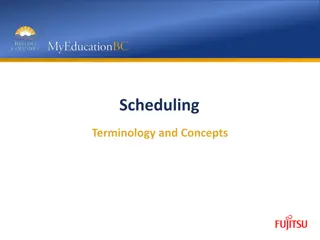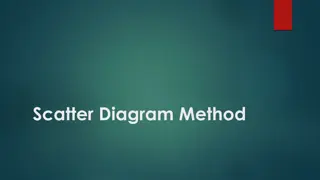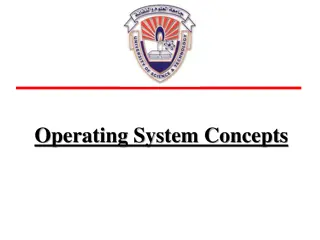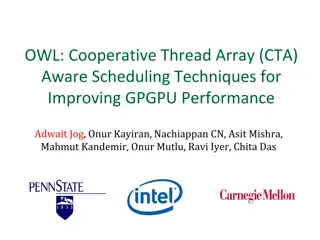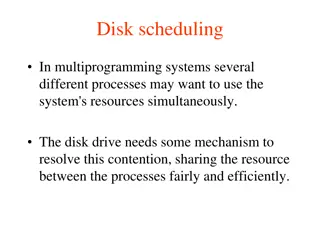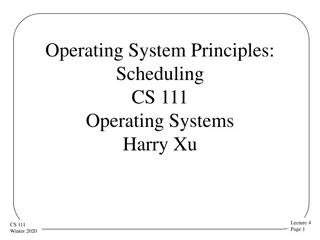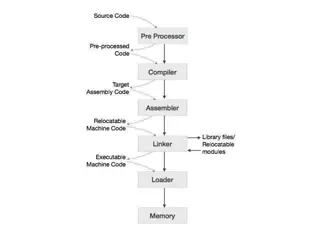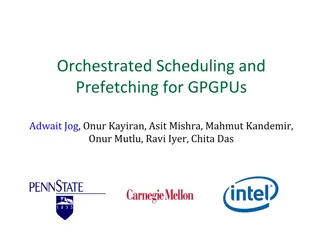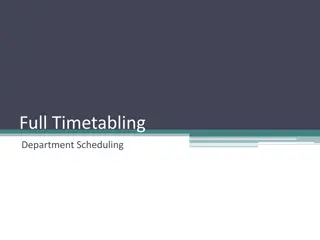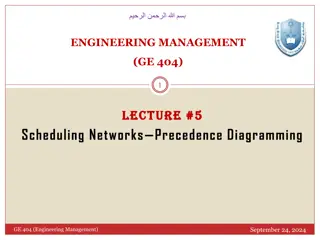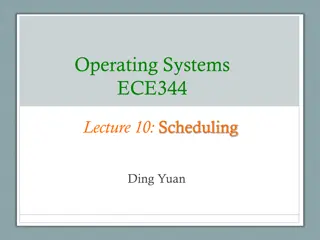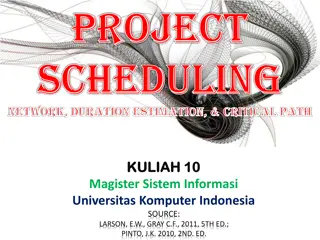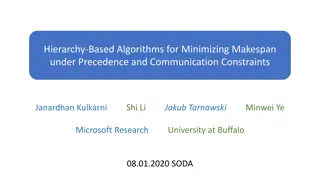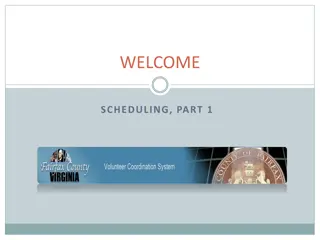Understanding the Precedence Diagram Method in Project Scheduling
The Precedence Diagram Method is a valuable tool for scheduling activities in project management. It helps in visualizing task dependencies, critical paths, and slack time, allowing for efficient project planning and execution. Through the method, one can define task attributes, determine predecessors, and optimize project schedules for various scenarios, enhancing project management efficiency.
Download Presentation

Please find below an Image/Link to download the presentation.
The content on the website is provided AS IS for your information and personal use only. It may not be sold, licensed, or shared on other websites without obtaining consent from the author. Download presentation by click this link. If you encounter any issues during the download, it is possible that the publisher has removed the file from their server.
E N D
Presentation Transcript
Project scheduling Project scheduling Precedence diagram method Precedence diagram method Project Management Project Management Magister Sistem Informasi Universitas Komputer Indonesia REFERENCES: LARSON, E.W., GRAY C.F., 2011, 5TH ED.; PINTO, J.K. 2010, 2ND. ED.
PRECEDENCE DIAGRAM METHOD The Precedence Diagram Method is a tool for scheduling activities in a project plan. It is a method of constructing a project schedule network diagram that uses boxes, referred to as nodes, to represent activities and connects them with arrows that show the dependencies. Critical Tasks, noncritical tasks, and slack time Shows the relationship of the tasks to each other Allows for what-if, worst-case, best-case and most likely scenario Key elements include determining predecessors and defining attributes such as early start date late start date early finish date late finish date Duration WBS reference
PRECEDENCE DIAGRAM METHOD Extension of AON Network Allows concurrent activities to overlap Restraints not required to model logical relationships Schedule logic is easier and quicker to develop Easier to modify Better represents work flow in continuous operations
Types of Task Relationship FS Finish to Start Finish Start SS Start to Start Start Start FF Finish to Finish Finish Finish SF Start to Finish Start Finish
Leads & Lags Activity Lead Lag Lag = time that a following activity is delayed from the start of the previous activity Lead = time that an activity precedes the start or finish of the next activity
Leads & Lags Normal Finish - Start Finish Start Modified by a Lead Finish Start Modified by a Lag Lead and Lag are used to Modify Relationships Lead and Lag Can be used with any Relationship Type (FS, FF, SS)
Remodeling an Appliance Activity Duration Predecessors A Conduct competitive analysis 3 - B Review field sales report 2 - C Conduct tech capabilities assessment 5 - D Identify relevant specification 2 A,B,C E Conduct telephone survey 3 D F Identify relevant specification improvements 3 E G Interface with marketing staff 1 F H Develop engineering specifications 5 G I Check and debug designs 4 H J Develop testing protocol 3 G K Identify critical performance level 2 J L Assess and modify product components 6 I, K M Conduct capabilities assessment 12 L N Identify selection criteria 3 M O Develop RFQ 4 M P Develop production master schedule 5 N, O Q Liaise with sales staff 1 P R Prepare product launch 3 Q
QUESTION Develop Gantt chart and create a complete activity network diagram. Identify the critical path.
Critical Path and Activity Slack Case J. Wold, project manager of Print Software, Inc. Wants you to prepare a project network; compute the early, late, and slack activity times; determine the planned project duration; and identify the critical path. His assistant has collected the following information for the Color Printer Drivers Software Project.
Project Network Case (Continued) ID Description Predecessor Time A External specifications None 8 B Review design features A 2 C Document new features A 3 D Write software A 60 E Program and test B 60 F Edit and publish notes C 2 G Review manual D 2 H Alpha site E,F 20 I Print manual G 10 J Beta site H,I 10 K Manufacture J 12 L Releaseand ship K 3
Greendale Stadium Case The G&E Company is preparing a bid to build the new 47,000 seat baseball stadium. The construction must start July 1, 2017, and be completed in time for the start of the 2019 season. A penalty clause $100,000 per day of delay beyond March 20, 2019, is written into the contract. Ben Keith, the president of the company, expressed optimism of obtaining the contract and revealed that company could net as much as $2 million on the project. He also said if they are successful, the prospects for future projects are quite good since there is projected a renaissance in building classic ball parks with modern luxury boxes. Assignment: Given the information provided in the next table, construct a network schedule for the stadium project and answer the following questions: 1. Will the project be able to be completed by the Marchdeadline? How long will it take? 2. What is the critical path for the project? 3. Based on the schedule would you recommend that G&E pursue this contract? Why? Include a one-page Gant chart for the stadium schedule.
ID Activity Duration (days) Predecessor(s) 1 Baseball Stadium 2 Clear stadium site 70 - 3 Demolish building 30 2 4 Set up construction site 70 3 5 Drive support piling 120 2 6 Pour lower concrete bowl 120 5 7 Pour main concourse 120 3,6 8 Install playing field 90 3,6 9 Construct upper steel bowl 120 3,6 10 Install seats 140 7,9 11 Build luxury boxes 90 7,9 12 Install jumbotron 30 7,9 13 Stadium infrastructure 120 7,9 14 Construct steel canopy 75 10 15 Light installation 30 14 16 Build roof supports 90 6 17 Construct roof 180 16 18 Install roof tracks 90 16 19 Install roof 90 17,18 20 Inspection 20 8,11,13,15,19
EMR Project Case No Activities Duration Predecessor 1 Electronic Medical Reference Project 2 Architectural Decision 5 days 3 Specification 4 Internal Specification 12 days 2 5 External Specification 7 days 2 6 Feature Specification 10 days 2 7 Design Phase 8 Voice Recognition 10 days 4SS+7 and 5 9 Case 4 days 4 and 5FS+1 10 Screen 2 days 4,5 11 Database 25 days 6 12 Microphone-soundcard 5 days 6 and 11FF-4 13 Digital Devices 7 days 6 14 Computer I/O 5 days 6 15 Review Design 5 days 8,9,10,11,12,13,14




